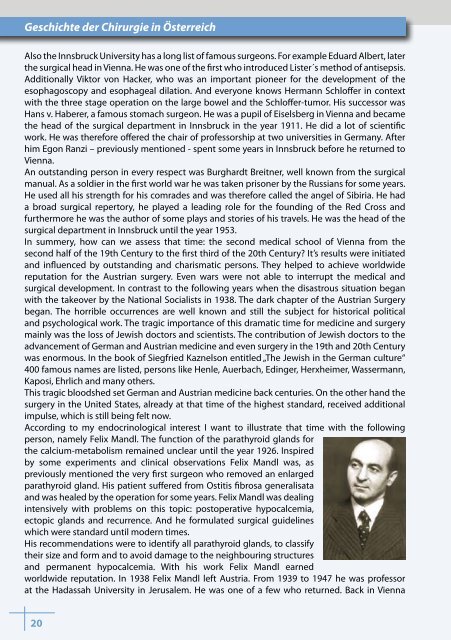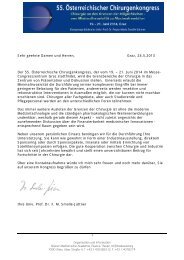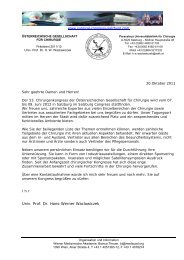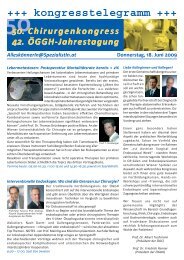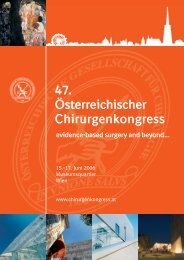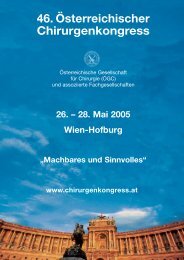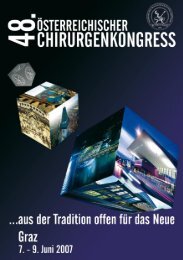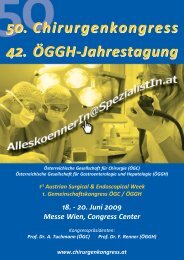3w - 54. Österreichischer Chirurgenkongress
3w - 54. Österreichischer Chirurgenkongress
3w - 54. Österreichischer Chirurgenkongress
Sie wollen auch ein ePaper? Erhöhen Sie die Reichweite Ihrer Titel.
YUMPU macht aus Druck-PDFs automatisch weboptimierte ePaper, die Google liebt.
Geschichte der Chirurgie in Österreich<br />
Also the Innsbruck University has a long list of famous surgeons. For example Eduard Albert, later<br />
the surgical head in Vienna. He was one of the first who introduced Lister´s method of antisepsis.<br />
Additionally Viktor von Hacker, who was an important pioneer for the development of the<br />
esophagoscopy and esophageal dilation. And everyone knows Hermann Schloffer in context<br />
with the three stage operation on the large bowel and the Schloffer-tumor. His successor was<br />
Hans v. Haberer, a famous stomach surgeon. He was a pupil of Eiselsberg in Vienna and became<br />
the head of the surgical department in Innsbruck in the year 1911. He did a lot of scientific<br />
work. He was therefore offered the chair of professorship at two universities in Germany. After<br />
him Egon Ranzi – previously mentioned - spent some years in Innsbruck before he returned to<br />
Vienna.<br />
An outstanding person in every respect was Burghardt Breitner, well known from the surgical<br />
manual. As a soldier in the first world war he was taken prisoner by the Russians for some years.<br />
He used all his strength for his comrades and was therefore called the angel of Sibiria. He had<br />
a broad surgical repertory, he played a leading role for the founding of the Red Cross and<br />
furthermore he was the author of some plays and stories of his travels. He was the head of the<br />
surgical department in Innsbruck until the year 1953.<br />
In summery, how can we assess that time: the second medical school of Vienna from the<br />
second half of the 19th Century to the first third of the 20th Century? It’s results were initiated<br />
and influenced by outstanding and charismatic persons. They helped to achieve worldwide<br />
reputation for the Austrian surgery. Even wars were not able to interrupt the medical and<br />
surgical development. In contrast to the following years when the disastrous situation began<br />
with the takeover by the National Socialists in 1938. The dark chapter of the Austrian Surgery<br />
began. The horrible occurrences are well known and still the subject for historical political<br />
and psychological work. The tragic importance of this dramatic time for medicine and surgery<br />
mainly was the loss of Jewish doctors and scientists. The contribution of Jewish doctors to the<br />
advancement of German and Austrian medicine and even surgery in the 19th and 20th Century<br />
was enormous. In the book of Siegfried Kaznelson entitled „The Jewish in the German culture“<br />
400 famous names are listed, persons like Henle, Auerbach, Edinger, Herxheimer, Wassermann,<br />
Kaposi, Ehrlich and many others.<br />
This tragic bloodshed set German and Austrian medicine back centuries. On the other hand the<br />
surgery in the United States, already at that time of the highest standard, received additional<br />
impulse, which is still being felt now.<br />
According to my endocrinological interest I want to illustrate that time with the following<br />
person, namely Felix Mandl. The function of the parathyroid glands for<br />
the calcium-metabolism remained unclear until the year 1926. Inspired<br />
by some experiments and clinical observations Felix Mandl was, as<br />
previously mentioned the very first surgeon who removed an enlarged<br />
parathyroid gland. His patient suffered from Ostitis fibrosa generalisata<br />
and was healed by the operation for some years. Felix Mandl was dealing<br />
intensively with problems on this topic: postoperative hypocalcemia,<br />
ectopic glands and recurrence. And he formulated surgical guidelines<br />
which were standard until modern times.<br />
His recommendations were to identify all parathyroid glands, to classify<br />
their size and form and to avoid damage to the neighbouring structures<br />
and permanent hypocalcemia. With his work Felix Mandl earned<br />
worldwide reputation. In 1938 Felix Mandl left Austria. From 1939 to 1947 he was professor<br />
at the Hadassah University in Jerusalem. He was one of a few who returned. Back in Vienna<br />
20


